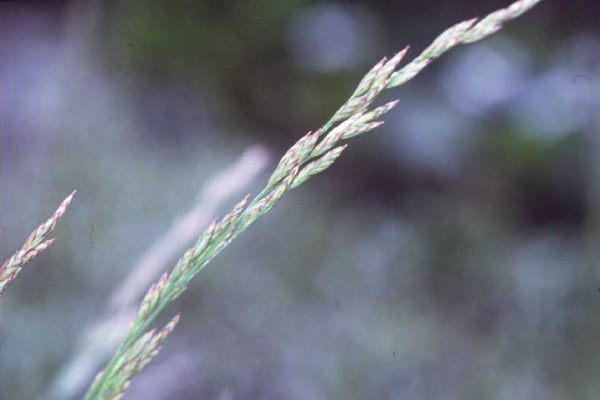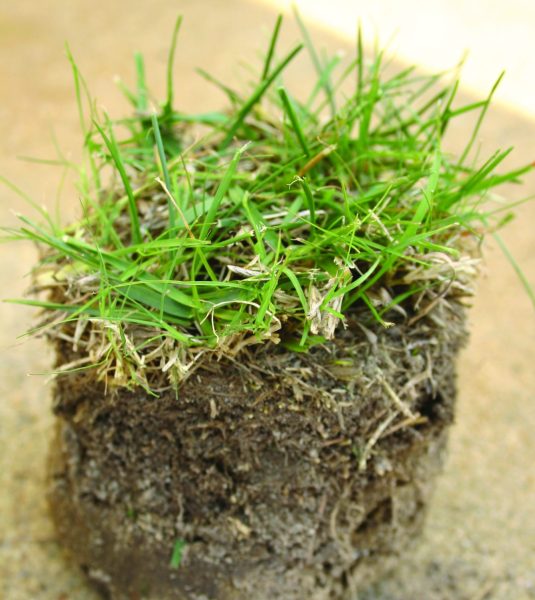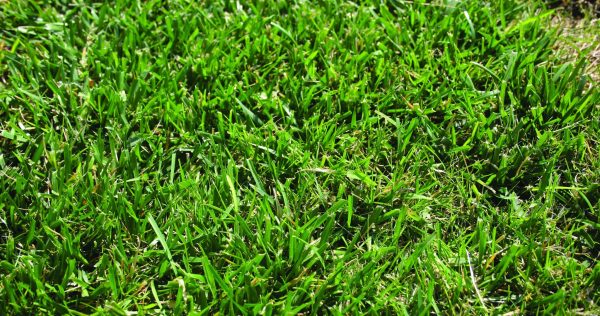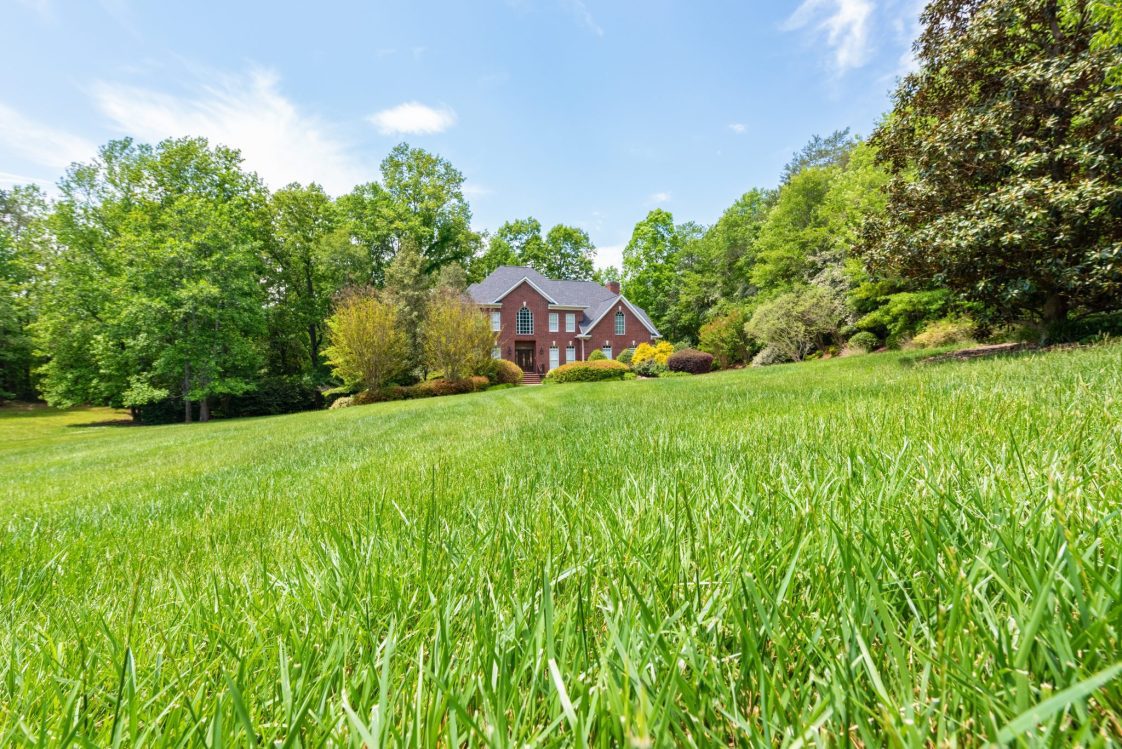Lawn & Garden

Tall fescue is a cool-season, perennial, bunch-type grass for north Alabama lawns. It is desirable for its texture, dark green color, and ability to establish quickly from seed. It does not have the heat or drought tolerance of warm-season grasses, but for those in the northern part of the state, it is a popular choice.
Description
 Cool-season grasses, such as tall fescue, grow best in daytime temperatures between 60 degrees F and 75 degrees F. In the middle of the summer, tall fescue will experience heat stress in Alabama and may go semidormant. The northern part of the state is the southern limit of tall fescue’s zone of adaptation and is considered the transition zone. Because of this, in especially hot or droughty summers, tall fescue lawns will suffer considerable damage and become thin and patchy. Even in a normal summer, some thinning of fescue lawns can be expected. A common practice is to maintain the desired density of tall fescue lawns in the Deep South by overseeding each fall to compensate for this. Overseeding is necessary for bunch-type grass species, as they cannot spread and cover large areas.
Cool-season grasses, such as tall fescue, grow best in daytime temperatures between 60 degrees F and 75 degrees F. In the middle of the summer, tall fescue will experience heat stress in Alabama and may go semidormant. The northern part of the state is the southern limit of tall fescue’s zone of adaptation and is considered the transition zone. Because of this, in especially hot or droughty summers, tall fescue lawns will suffer considerable damage and become thin and patchy. Even in a normal summer, some thinning of fescue lawns can be expected. A common practice is to maintain the desired density of tall fescue lawns in the Deep South by overseeding each fall to compensate for this. Overseeding is necessary for bunch-type grass species, as they cannot spread and cover large areas.
Tall fescue withstands drought conditions and moderate wear better than other cool-season grasses in the South. However, tall fescue’s wear tolerance is not comparable to warm-season grasses, such as bermudagrass and zoysiagrass. Tall fescue tolerates light to moderate afternoon shade but performs best in full sun. Although tall fescue grows best in well-drained soils of moderate fertility with a pH of 5.5 to 6.5, it adapts to a wide variety of soil conditions.
Kentucky-31 (K-31) is one of the most common cultivars developed for grazing livestock. Newer cultivars, referred to as turf-type tall fescues, have a finer texture, shorter growth habits, darker color, and greater density and shade tolerance than K-31. Several of these turf types are also more disease tolerant and more resilient to summer heat stress. With any tall fescue selection, the bunching growth habit, limited ability to spread, and summer-induced thinning will require periodic overseeding.
Varieties
Several newer cultivars of tall fescue are available. Varieties that have performed well in southeastern variety trials include Firenza II, Bonfire, Zion, Avenger III, Symphony, Degas, and Xanadu. These new cultivars have denser growth habits and a finer texture. Kentucky 31 is still a dependable tall fescue turfgrass, tolerating hot summers with proper irrigation management. It is the coarsest-textured tall fescue variety and is often used in pastures and roadside plantings.
Buying single varieties of tall fescue seed for turfgrass is often impossible. Instead, tall fescues are sold as blends of multiple varieties. Often, the exact varieties in certain brand name blends will change from year to year as seed availability varies and new varieties are released.
Establishment
 Ease of establishment from seed is a major contributor to the popularity of tall fescue. Planting time and good soil preparation are essential for the greatest success.
Ease of establishment from seed is a major contributor to the popularity of tall fescue. Planting time and good soil preparation are essential for the greatest success.
- First, take a soil sample. See Extension publication “Home Soil Testing: Taking a Sample,” ANR-0006-A on the Extension website (www.aces.edu) or contact your county Extension office. Submit the sample to the Soil, Forage, and Water Testing Laboratory for pH and fertility recommendations. Ideally, this should be done a few months before planting.
- Before adding amendments, remove hard-to-control weeds such as nutsedge or bermudagrass.
- For best results, mow a week before herbicide treatment.
- Then spray the area with a nonselective herbicide containing glyphosate to remove any existing weeds. Avoid using combination herbicides that have chemicals with residual control. Be sure to check the label for approved site uses.
After weeds are eliminated, broadcast organic amendments and limestone according to soil test recommendations, and work into the seedbed to a depth of 6 to 8 inches. A starter fertilizer should be applied as close to the planting date as possible to minimize nutrient losses.
Hand rake the area removing debris and smoothing the soil surface. Buried stumps or other organic material will eventually decay, leaving a hole in the soil. Maintenance is much easier on a consistently even turf surface. Rolling the seedbed smooth helps if the surface is dry and the subsurface is moist. Avoid excessive rolling.
Seeding. September to October is the best time to plant tall fescue in north Alabama. This provides time for strong root establishment before the onset of summer heat. Planting in the spring is risky and often requires large amounts of water, increasing the chance of seedling diseases. Seedlings may not fully establish before winter if planted after October.
Using a mechanical spreader, spread seed at a rate of 5 to 8 pounds per 1,000 square feet. Having the rate too high will crowd seedlings, which decreases the ease of lawn establishment and increases disease problems. The uniform distribution of the seed is important to appearance and maintenance.
- Divide the seed into two equal amounts.
- Sow half in one direction over the total area to be seeded.
- Sow the other half in the opposite direction.
- After seeding, lightly rake or drag the area.
- Lightly roll the seedbed ensuring seed-to-soil contact. Do not bury the seeds. Mulch, such as pine straw, helps prevent washing, retains moisture, and results in quick and uniform germination. Other mulches can contain weeds and competing cool-season grasses and should be used only if clean. Commercial netting can be used on slopes to help prevent soil erosion and seed movement during irrigation and rain.
Irrigation. At the time of seeding, the prepared soil should have good moisture in the top 4 to 6 inches, but the surface should be dry enough for the seeding operation.
Surface drying is a major cause of seedling failure. After seeding, ensure surface moisture until germination. This usually requires light irrigation one to three times each day until seedlings emerge. As the seedlings develop, apply water frequently enough to prevent wilting, but gradually decrease the frequency and the increase water amount to encourage a deeper root system. The goal is to irrigate the mature lawn no more than once or twice per week. In a typical Alabama winter, rainfall is often plentiful enough that no irrigation is required on an established lawn.
Excessive irrigation is the single biggest mistake homeowners make in caring for their lawns. Too much surface moisture increases the chance of damping-off (seedling disease). Applying water too fast erodes the soil surface and moves the seed. To maintain the appearance and long-term health of a lawn, water deeply and infrequently. An average lawn uses 1 to 1 1⁄2 inches of water each week in the summer when fully established and less in the spring and fall. Consider weekly rainfall totals when deciding how often to irrigate. There is no need to irrigate if natural rainfall is supplying this much water.
Mowing. Begin mowing seedlings at 2 to 3 inches once the entire stand is about 2 1⁄2 inches tall. Do not mow when wet. Raise the mower 0.5 inches higher in hot weather and maintain it at 3 inches during the summer to increase heat tolerance. One mowing per week is normally sufficient; however, during the spring you may need to mow two times per week to maintain high turf quality. The general rule of thumb is to remove no more than one-third of the leaf material in one mowing. For example, if the height of the cut is 2 inches, mow before growth reaches 3 inches.
Maintenance
 Fertilization. Do not fertilize tall fescue lawns at the same time or amount as warm-season grasses. Tall fescue tolerates low fertility but looks best with 2 to 4 pounds of nitrogen per 1,000 square feet per year. Most of the fertilizer should be applied to tall fescue lawns in the fall.
Fertilization. Do not fertilize tall fescue lawns at the same time or amount as warm-season grasses. Tall fescue tolerates low fertility but looks best with 2 to 4 pounds of nitrogen per 1,000 square feet per year. Most of the fertilizer should be applied to tall fescue lawns in the fall.
Supply phosphorus and potassium only following a soil test recommendation. If your soil test indicates that you do not need phosphorous and potassium, there is no need to use a complete fertilizer. You should only apply nitrogen if all the other soil nutrients are sufficient.
Apply about 1 pound of nitrogen per 1,000 square feet each month in late September, October, and November. Apply 1⁄2 pound of nitrogen around February and March if you see that additional nitrogen is necessary. If you use slow-release nitrogen fertilizer, apply 3 pounds of nitrogen in September. Overfertilizing in summer will compound heat and drought stress.
Irrigation. Proper irrigation management is essential to the durability of an established fescue lawn. Irrigate when signs of moisture stress appear—gray color with wilted or rolled leaves. Water to a soil depth of 4 to 8 inches. This is generally 1 inch of water per week. Early morning is the best time to irrigate. In the middle of the summer, 11⁄2 inches of water per week may be necessary. Irrigation should be applied in one to two applications during the week to encourage deep root development.
Overseeding. Because of summer stress, tall fescue lawns eventually become thin. Overseeding is necessary to maintain a dense lawn and minimize weed competition. Turf thinning occurs more rapidly in cases of poor management practices such as improper irrigation, too much nitrogen fertilizer, excessive seeding rates, improper mowing height, and seeding too late in the fall or spring. Additional stresses may include drought, pests, or environmental conditions such as compacted soil or nearby tree root competition.
When it is time to overseed, estimate the loss percentage and multiply that number by the establishment seeding rate. For example, if the lawn is 50 percent dead, reseed with 50 percent x 5 pounds = 2 1⁄2 pounds per 1,000 square feet. Remember to overseed in fall just as recommended for establishment.
Seed-to-soil contact is necessary for successful overseeding. Hand rake thin areas with an iron rake or rent a core aerator. If an area is completely bare, follow the establishment procedures mentioned previously.
Weeds. A healthy and dense turf provides the best defense against weed invasion. However, due to the bunch growth habit of tall fescue, this is difficult to achieve. The newer turf-type tall fescues have a denser growth but will still benefit from chemical weed control.
Some herbicide applications will be necessary for proper tall fescue lawn maintenance. Control of broadleaf weeds, such as dandelion and plantain, can be achieved with applications of selective broadleaf herbicides labeled for tall fescue lawns.
Crabgrass and other summer annual weeds are easier to control with a spring application of pre-emergence herbicides. There are limited options for postemergence crabgrass control in home lawns. Products that contain Quinclorac for crabgrass control are limited to two applications per season and should not be applied when temperatures exceed 85 degrees F. See Extension website for publication “Home Lawns: Chemical Weed Control IPM Guide” (IPM-590) for home lawn weed control recommendations.
Insects. As with other turfgrasses, several insects can become problematic. Before applying any pesticide, make a positive identification of the insect causing
the damage. This ensures that an accurate control is applied, proper application timing is achieved, and the need for future treatments is reduced. Your county Extension office can assist you with pest identification or see the integrated pest management (IPM) guides on the Alabama Extension website.
Diseases. Kentucky 31 tall fescue is relatively tolerant to most common turfgrass diseases. Some of the new turf-type cultivars are even more tolerant. The best disease management tools are proper irrigation, mowing height, and fertilizer routines. Excess nitrogen, prolonged drought, poor drainage, or prolonged saturation can contribute to disease development.
Brown patch is the most destructive disease in tall fescue, but it can be managed with repeated applications of a lawn fungicide and good cultural practices. As with insects, the proper identification of the disease is necessary for identification of accurate treatment methods and future prevention. See “Home Lawns: Disease Control IPM Guide” (IPM-1292) on the Alabama Extension website.
 Revised by Lucy Edwards, Regional Extension Agent, and Rhonda Britton, Regional Extension Agent, both in Home Grounds, Gardens, and Home Pests, Auburn University. Originally written by Jeffery M. Higgins, former Extension Turfgrass Specialist, all with Auburn University.
Revised by Lucy Edwards, Regional Extension Agent, and Rhonda Britton, Regional Extension Agent, both in Home Grounds, Gardens, and Home Pests, Auburn University. Originally written by Jeffery M. Higgins, former Extension Turfgrass Specialist, all with Auburn University.
Revised April 2022, Tall Fescue Lawns, ANR-0231

